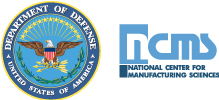045 – “718 AMXS Thermal Imagery”
Author: MSgt John A. Kester
Company: 718th Aircraft Maintenance Squadron, Kadena AB
Phone: (315)-634-6347
Email: john.kester@us.af.mil
The United States Air Force needs troubleshooting tools that are effective across specialties.
Some aircraft are very new, and some may have been worked on by our grandfathers. Maintenance of these airframes spans a broad variety of system types with different troubleshooting practices. Manning constraints are pushing cross utilization to of specialties more than ever before. Support of such an initiative is difficult without common tools across the specialties. The majority of the specialties deal with electronics, hydraulics, RF, liquids, and gasses. One thing all of these areas have in common is heat.
Thermal cameras are simple to use devices that can be applied to many maintenance trades. They display hot and cold spots with a simple point and shoot. A major advantage of a camera is that images can be stored for later use or sent to other subject matter experts.
The applications of thermal cameras are almost beyond counting. All of the below can be checked from a safe distance with a thermal camera without disconnection, removal, or item replacement.
Electricians
Shorted wiring will be noticeably warmer at the short.
Damaged or partial contacts will be warmer Properly operating components will be warmer then ambient.
Overloaded components will be hot
Environmental Control
Coolant leaks will often be cooler then ambient Gas leaks will often be cooler then ambient (LOX, GOX, R-134A) Bleed air leaks may often be spotted when the leak sprays hot air A chilled gas source will lead a technician directly to an issue Reveal pressurization issues at a glance Plumbing leaks create cold spots in walls
Communications and RADAR
Higher power lines will be warmer then ambient after operation.
Broken or crushed lines will have a temperature change at the problem area Antenna water ingress – temperature difference at water line Amplifiers may be extremely hot from reflected power or cold from inoperability
Hydraulics
The hottest part of any hydraulics system will be the pump and any rotary actuators. Properly functioning actuators should remain cooler than the pump.
Bypassing/internally leaking parts will be warmer then the components around them.
Non-functional regulators may be hotter, cooler than expected, or not change in temperature when commanded to change.
Constraints within the United States Air Force are pushing us to do more with less, but also to evolve and improve. Thermal imaging is a cheap and easy to use resource with a huge range of applications. It can be safely used anywhere electrical equipment is authorized and could cut hours from troubleshooting times. Skills for use of thermal cameras are easy to learn and transfer easily across airframes and trades. Thermal imaging technology could be a huge step forward in the evolution of aviation maintenance that has the potential to decrease cost, training time, and repair times.

